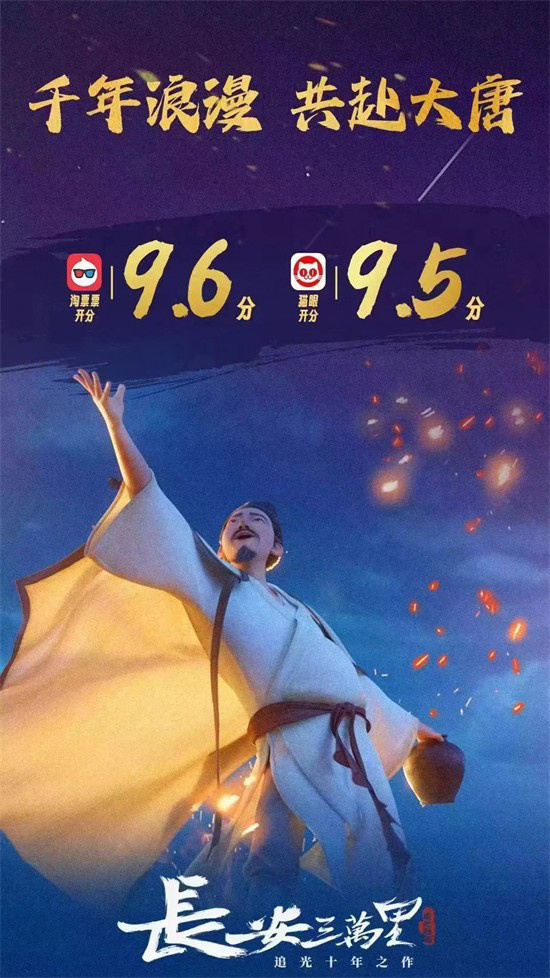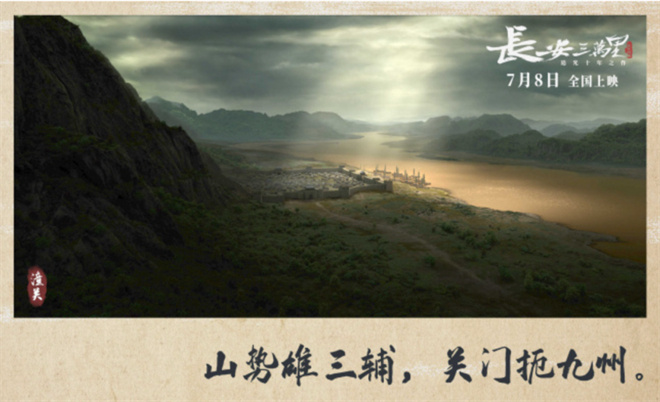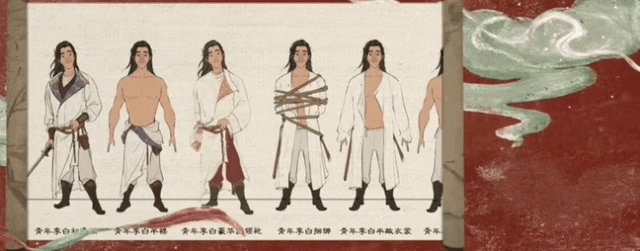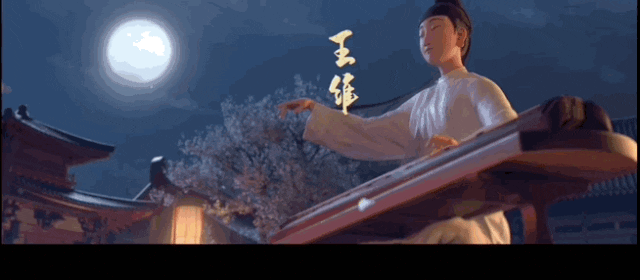The next explosion! The Director Reveals the Chinese Romance of Chang ‘an Three Wan Li
Special feature of 1905 film network "I was born to be useful, spin a thousand pieces of silver, all of them come back!."With the impassioned recitation,li pofamous literary pieceInvitation to WineOn the big screen, it turned into an unconstrained visual spectacle, which made people fascinated and shocked.

The new film "Three Wan Li in Chang ‘an" starts from the first Tang poems, and takes the audience back to the bright times when the stars shone thousands of years ago. With the friendship between Gao Shi and Li Bai spanning decades as the axis, it outlines the magnificent group image of the stars in the Tang Dynasty.
The film has a good reputation in the screening stage. As the pioneering work of the "New Culture" series, it is expected to become the next summer animation explosion.

In an exclusive interview with 1905 Film Network, directors Xie Junwei and Zou Jing told us that they hoped to present the Tang Dynasty in an all-round way from the perspectives of scenery, character modeling and etiquette paradigm, and to awaken the cultural genes flowing in the blood with 48 Tang poems and familiar names to convey the romance unique to China people.
"Chang ‘an is an ideal place for poets, and’ Three Wan Li’ is the distance between them and the ideal, and it is also the distance between us and the ideal. Poetry is there, books are there, and Chang ‘an is there. "Three Wan Li in Chang ‘an" is a poem we wrote to the sages, and it is also a spiritual inheritance, "Xie Junwei said.

"Chinese confidant"
As the pioneering work of "New Culture Series" of light-chasing animation, Three Wan Li in Chang ‘an aims to capture shining figures and classic works widely respected in the history of China as creative objects and show the beauty of traditional culture in the form of animation.
The first thing that came to mind was the "Tang Dynasty". "The Tang Dynasty is a self-confident and tolerant dynasty, and Tang poetry is integrated into the blood of everyone. When it comes to Tang poetry, Li Bai will naturally blurt it out," Xie Junwei said.

Everyone knows Li Bai. He is a "Poet Fairy" and "Brewmaster", and he is also a "fallen immortal" who is pure and refined, but these auras also invisibly widen the distance between him and the audience.
The director thought of looking for an "ordinary person" to stare at Li Bai. In this way, another hero — — Gao Shi, a frontier poet, came into being.
"In history, Gao Shi and Li Bai were good friends, and he himself was legendary. Before the age of 50, it was difficult all the way, and it was not until the Anshi Rebellion that he finally achieved great success. It is easier for the audience to bring in his friendship with Li Bai from the perspective of ordinary people. "

Li Bai and Gao Shi, one is a free and wild "fallen immortal" and wrote "oh, how can I gravely bow and scrape to men of high rank and men of high office, who never will suffer being shown an honest-hearted face"; A down-to-earth "worldly person" is determined to "go straight to Chang ‘an and knock on the Tianzi Gate".
The sharp contrast between their personalities and acting styles has become the main source of conflicts in movies and dramas, but behind their different life choices, they all reveal their unremitting pursuit of poetry and ideals.

The two directors interpret their friendship like this: "Li Bai and Gao Shi admire and appreciate each other. When they first met, Gao Shi said that I had never seen such a talented person, such a naive and romantic person, and he admired Li Bai; For Li Bai, after middle-aged sumo wrestling, he said to Gao Shi: The silver saddle shines on a white horse, and it is like a meteor. This poem was written by me according to your appearance twenty years ago, and he is also expressing his appreciation for Gao Shi. "
"Their personalities are so different, but they can be together and become bosom friends. This is the romance of Chinese bosom friends that we want to embody."

One of the externalized forms of this "romance" is the three sumo fights between Gao Shi and Li Bai. Director Zou Jing told us, "The social atmosphere in the Tang Dynasty was very martial, and sumo was a popular form of sports at that time. They have three sumo wrestlers in their lives, from the youthful vigor to the vicissitudes of middle age. The body may have declined but the spirit is still there. We want to create a spiritual transmission that spans time. "
At the scene of the road show, an audience asked the director what kind of feelings besides friendship existed between Li Bai and Gao Shi in the film. The director responded: "In fact, there is no need to define what kind of emotion it is. Li Bai and Gao Shi are very important people to each other, and this state is what we want to express."

"Chang ‘an Three Wan Li"
From the splendid Chang ‘an on the top of the mountain, the beautiful Yangzhou with Erming Moon is Yangzhou, to the Yellow Crane Tower on the first floor of the world, the wonders of the Three Gorges with water and sky, and then to the magnificent scenery of Liangyuan, Tongguan, Songzhou and Jibei. …No wonder some people say that Three Wan Li in Chang ‘an is a vivid Tourism Map of Datang.

In order to create a grand scene of the Tang Dynasty thousands of years ago, the master chose the creative mode of combining data archaeology with field collection. On the one hand, I visited Shaanxi History Museum to observe the sand table map of Chang ‘an City, and referred to a large number of books and ancient paintings to reproduce the prosperous Chang ‘an in the prosperous Tang Dynasty.

On the other hand, they also personally went to Tongguan and Songzhou to collect the wind. Zou Jing recalled, "When we were in Tongguan, we stood on the wall and looked out, and we really understood why Tongguan was easy to defend and difficult to attack; We went to Songzhou and saw its walls and mountains linked together, then we understood the so-called natural barrier of the ancients. Many things have to be visited in person to understand the particularity of its geographical environment. "

Not only that, "Chang ‘an Three Wan Li" is not relaxed in the details of modeling, etiquette and props.According to the director, the crew also specially invited a etiquette guide to help the main creator reproduce all kinds of etiquette among the literati in the Tang Dynasty, such as the representative ceremony of crossing hands, not bumping glasses when touching glasses, the sense of ritual when Li Bai buried Wu Guide, and all kinds of details of "moving, sitting, lying and walking" are well documented.
"We want to present the real Tang Dynasty in detail, not only aesthetically, but also strive to make the audience return to Tang Dynasty at a glance," Xie Junwei said.

In order to restore the style of the Tang Dynasty in an all-round way, the figures in the film also refer to the proportions and shapes of figures in Tang terracotta warriors, murals and ancient paintings, forming a "tang style shape" with a majestic upper body because of its martial arts.
Specific to the two protagonists, Gao Shi has 22 versions, ranging from 8 to 60 years old, and Li Bai also has 15 versions, from youth to old age.

"Li Bai’s middle-aged state is actually the face that we are most familiar with. The inspiration comes from the illustrations next to Tang poetry in primary schools. We first determined that middle-aged Li Bai would use this shape, while Li Bai in his later years wore a plain clothes, like a youth, and returned to the true state."

In addition to the two protagonists, another highlight of the film is Du Fu, a lovely childhood, which is in sharp contrast with the gloomy and sad image of "Poet Saint" in the public impression.
The director said that this familiar and unfamiliar feeling is exactly what they are pursuing. "Is Du Fu a state of compassion from birth?" He was also a naughty and lovely child when he was a child. After he experienced setbacks and experiences, he finally became Du Fu now. This is what we want to express. We want to present these poets and these events to everyone in a more three-dimensional and flesh-and-blood way. "
 Childhood du fu
Childhood du fu
In the director’s view, "Three Wan Li in Chang ‘an" tells the story of Gao Shi and Li Bai’s deep love for each other across time, and it is also a touching chapter in which the stars of the Tang Dynasty rise and fall with the times and realize their life ambitions under the magnificent background of the times.
In a limited time, the master also made famous historical figures such as Wang Wei, He Zhizhang, Zhang Xu, Cui Zongzhi, Wang Changling, Cen Can, Li Yong, Cenfuzi, Dan Qiusheng, Li Guinian, Ge Shuhan, Guo Ziyi, Princess Yuzhen appear in turn, and constructed a vivid picture of all beings in the Tang Dynasty.
"These sages in the movies made their own choices in the face of life setbacks and difficult pressures, which ultimately affected the direction of life. We will encounter the same difficulties they encountered in those years today, and I hope their choices will give the audience strength, which is the core theme of this film, "Zou Jing said.

There are a total of 48 Tang poems in the film, and how to visualize the artistic conception of Tang poems has become a big challenge for the master.
They finally chose Yellow Crane Tower, Jiang Jin Jiu and Yan Ge Xing for presentation, and Jiang Jin Jiu is undoubtedly the most difficult.

Director Zou Jing revealed: "The production cycle of the whole project is three years, and the production time span of" Into the Wine "is close to two years, and one shot has been done for half a year. This poem is particularly rich in emotion, interwoven with Li Bai’s frustration and ambition, grief and heroism, so we decided to present the world in poetry with a surreal expression. "
"Every link of this play is very difficult, from storyboard, design, animation performance, special effects and even dubbing, it is very challenging. It can be said that all our animation imagination and what we have learned are put into this poem."

To reproduce the classics in a visual way, so that poetry can resonate with contemporary audiences across the Millennium, it should also be in harmony with Gao Shi’s finishing line: "Poetry is there, books are there, and Chang ‘an is there."
"This is the origin of our creation, and the spirit of the poets has been handed down into poems." Chang ‘an Three Wan Li "is a work of spiritual inheritance and a poem for the sages."